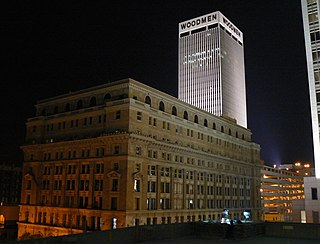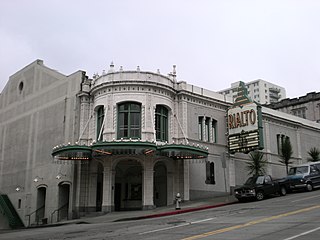
Broadway, until 1890 Fort Street, is a thoroughfare in Los Angeles County, California, United States. The portion of Broadway from 3rd to 9th streets, in the Historic Core of Downtown Los Angeles, was the city's main commercial street from the 1910s until World War II, and is the location of the Broadway Theater and Commercial District, the first and largest historic theater district listed on the National Register of Historic Places (NRHP). With twelve movie palaces located along a six-block stretch of Broadway, it is the only large concentration of movie palaces left in the United States.

The Van Allen Building, also known as Van Allen and Company Department Store, is a historic commercial building at Fifth Avenue and South Second Street in Clinton, Iowa. The four-story building was designed by Louis Sullivan and commissioned by John Delbert Van Allen. Constructed 1912–1914 as a department store, it now has upper floor apartments with ground floor commercial space. The exterior has brick spandrels and piers over the structural steel skeletal frame. Terra cotta is used for horizontal accent banding and for three slender, vertical applied mullion medallions on the front facade running through three stories, from ornate corbels at the second-floor level to huge outbursts of vivid green terra cotta foliage in the attic. There is a very slight cornice. Black marble facing is used around the glass show windows on the first floor. The walls are made of long thin bricks in a burnt gray color with a tinge of purple. Above the ground floor all the windows are framed by a light gray terra cotta. The tile panels in Dutch blue and white pay tribute to Mr. Van Allen's Dutch heritage of which he was quite proud.. The Van Allen Building was declared a National Historic Landmark in 1976 for its architecture.

J.L. Brandeis & Sons, commonly referred to by Midwesterners as Brandeis, was a chain of department stores located in the Omaha, Nebraska area started by Jonas L. Brandeis in 1881. It was purchased by Younkers for $33.9 million in 1987, when the stores were converted to the Younkers name.

The South Omaha Main Street Historic District is located along South 24th Street between M and O Streets in South Omaha, Nebraska. It was added to the National Register of Historic Places in 1989. Home to dozens of historically important buildings, including the Packer's National Bank Building, the historic district included 129 acres (0.52 km2) and more than 32 buildings when listed.

El Museo Latino is a museum featuring Latino and Hispanic art and history that is located at 4701 South 25th Street in South Omaha, Nebraska. Established in 1993, by Magdalena García, it is the first Latino art and history museum and cultural center in the Midwest.

The Rose Blumkin Performing Arts Center or The Rose, also known as the Astro Theater, originally opened as The Riviera. It is located in downtown Omaha, Nebraska. Built in 1926 in a combination of both Moorish and Classical styles, the building was rehabilitated in 1986.

The Bradford–Pettis House is a historic house located at 400 South 39th Street in Midtown Omaha, Nebraska. It was designated an Omaha Landmark on February 26, 1980, and added to the National Register of Historic Places on July 21, 1983.
John Latenser Sr. (1858–1936) was an American architect whose influential public works in Omaha, Nebraska, numbered in the dozens. His original name was Johann Laternser.

The Herndon House, later known as the International Hotel and then the Union Pacific Headquarters, was an early hotel located at Ninth and Farnam Streets in present-day Downtown Omaha, Nebraska. Built in 1858 by Omaha pioneer Dr. George L. Miller along with several associates, it was financed by the sale of city-donated land and a $16,000 loan. It was used as the headquarters building of the Union Pacific Railroad for more than 50 years; it was demolished in 1922.

The Broadway Theater District in the Historic Core of Downtown Los Angeles is the first and largest historic theater district listed on the National Register of Historic Places (NRHP). With twelve movie palaces located along a six-block stretch of Broadway, it is the only large concentration of movie palaces left in the United States. The same six-block stretch of Broadway, and an adjacent section of Seventh Street, was also the city's retail hub for the first half of the twentieth century, lined with large and small department stores and specialty stores.

The Rialto Theatre in Tacoma, Washington was built in 1918 to showcase movies. Its design reflects the affluence following World War I. It reflects the character of a palace and is the result of efforts by entrepreneur Henry T. Moore and Tacoma architect Roland E. Borhek. Designed to hold 1500 patrons and retail space. The two-and-a-half-story structure is in the historic downtown of Tacoma. The area has long been associated with theaters and entertainment. The theater is freestanding, with a dramatic view on an incline with a classical façade sheathed of glazed white terra cotta. Both the interior and exterior retain most of the original design of Roland E. Borhek. The theater has an auditorium, proscenium with stage, a relocated projection booth, balcony, lobby, and commercial space. It has been altered with the removal of the storefronts and marquee. On the inside, the lobby's decorative ceiling has been hidden and the concession areas expanded.

The Elmwood Park neighborhood in Omaha, Nebraska is a historically significant area that was developed in the late 19th and early 20th century. It extends from Leavenworth Street on the north to Center Street on the south; from South 50th Street on the east to South 72nd Street on the west. Home to ethnic Swede celebrations through the 1950s, today the neighborhood's park hosts the city's "Shakespeare on the Green" festival.
Rocheford & Gould were brick manufacturers and construction contractors in early Omaha, Nebraska. The firm built numerous brick structures during Omaha's transition from the wooden buildings of Nebraska's territorial days to more permanent structures. The buildings the firm built included breweries, schools, packing houses, business blocks, Vaudeville theaters, street car barns and power houses, and civic buildings. Many of the structures the firm built have been demolished but a few of their earliest structures still exist and are listed on the National Register of Historic Places.
The Omaha Athletic Club was a social club building located at 1714 Douglas Street in Downtown Omaha, Nebraska, United States. The idea of such a building in downtown Omaha originated in 1915 when a group of Omaha businessmen, including George Brandeis, met to discuss its establishment.
Boyd's Theater and Opera House was a theater and opera house at 1621 Harney Street in Downtown Omaha, Nebraska. It was demolished in 1920 and the property redeveloped for the then owner's department store business.

The Elsasser Bakery is a building at 1802 and 1804 Vinton Street in South Omaha, Nebraska, USA. The building was constructed in 1923 for the William L. Elsasser Bakery. The Elsasser name is carved into a stone panel at the top of the red brick building. The building was added to the National Register of Historic Places in 2006 as part of the admission of the Vinton Street Commercial Historic District. The building's main occupant is currently the River City Saloon.

The Arthur G. Rocheford Building is a historic commercial building at 1717 Vinton Street in South Omaha, Nebraska, United States. The building was built in 1913 to house Arthur G. Rocheford's Globe Plumbing Company. Rocheford served as the general contractor during construction of the building. The building was added to the National Register of Historic Places in 2006 as part of the admission of the Vinton Street Commercial Historic District.
The World Theater was a vaudeville and movie theater at 1506 Douglas Street in downtown Omaha, Nebraska. Its name was changed to the Omaha Theater in February 1935 when it was sold to new management. It closed on February 26, 1978, and was razed in 1980 to allow for the construction of a parking garage.
The Moon Theater was a silent movie theater at 1410 Douglas Street in Downtown Omaha, Nebraska. The 1,600-seat theater was built on the site of Omaha's first movie theater, the Parlor. In later years the theater was renamed the Town Theater and eventually the Cooper Theater. The building was demolished in 1976.















